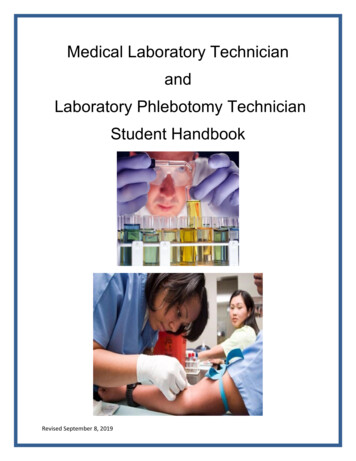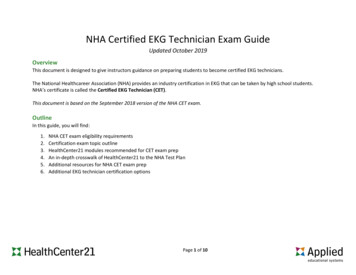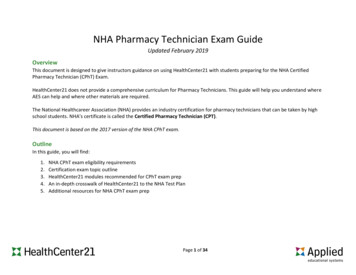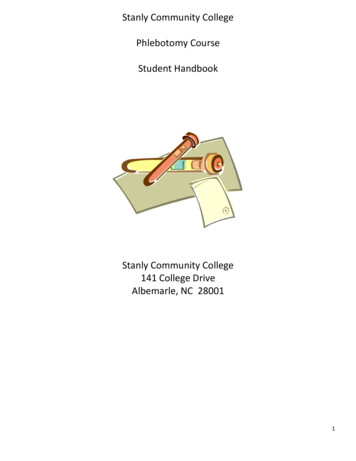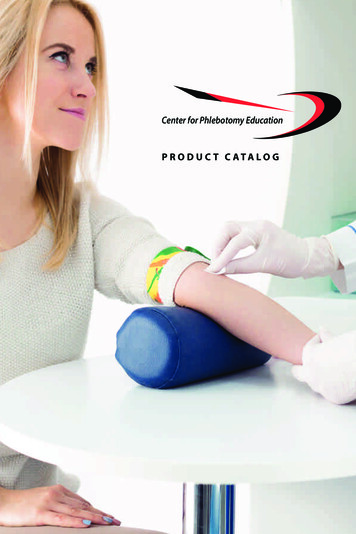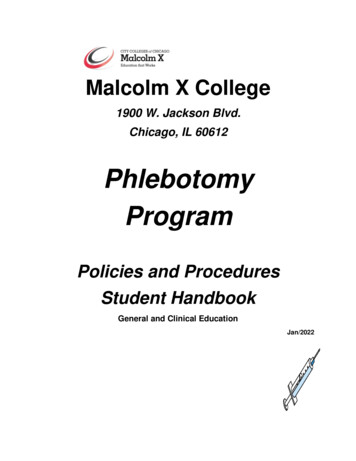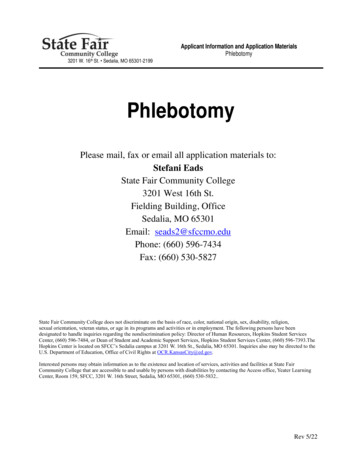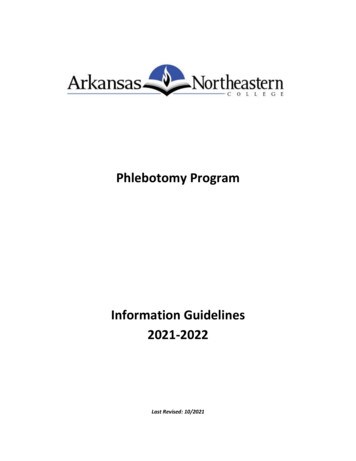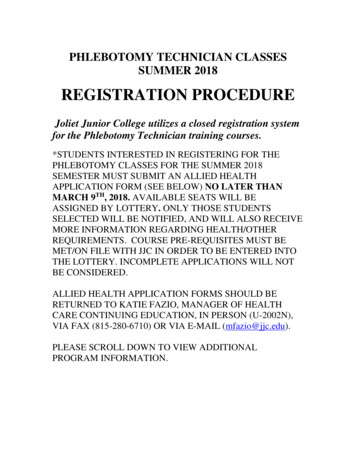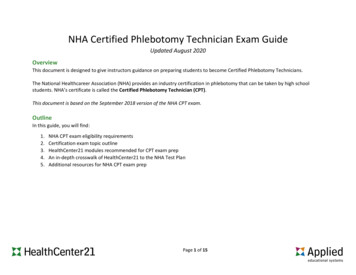
Transcription
NHA Certified Phlebotomy Technician Exam GuideUpdated August 2020OverviewThis document is designed to give instructors guidance on preparing students to become Certified Phlebotomy Technicians.The National Healthcareer Association (NHA) provides an industry certification in phlebotomy that can be taken by high schoolstudents. NHA’s certificate is called the Certified Phlebotomy Technician (CPT).This document is based on the September 2018 version of the NHA CPT exam.OutlineIn this guide, you will find:1.2.3.4.5.NHA CPT exam eligibility requirementsCertification exam topic outlineHealthCenter21 modules recommended for CPT exam prepAn in-depth crosswalk of HealthCenter21 to the NHA Test PlanAdditional resources for NHA CPT exam prepPage 1 of 15
1. Eligibility Requirements for the NHA CPT ExamIn order to sit for the NHA CPT exam, students must have all of the following:1. A high school diploma or GED equivalency2. Successful completion of a CPT training programHigh school students may earn provisional certificates prior to graduation. Key information to note includes:1. High school students who meet eligibility requirements must register for the exam within 12 months before graduation2. A provisional certificate expires 12 months from the exam date3. After graduation, graduates may apply to convert the active provisional certificate to a full certificate2. NHA CPT Exam Topic OutlineCore knowledge for a phlebotomy technician includes: Phlebotomy FundamentalsSafety and CompliancePatient PreparationRoutine Blood CollectionsSpecial CollectionsProcessing SpecimensThe NHA CPT exam measures this knowledge by asking questions across six domains:1. Safety and Compliance2. Patient Preparation3. Routine Blood Collections4. Special Collections5. Processing6. Core KnowledgeFor more details on the NHA CPT exam content, see www.nhanow.comPage 2 of 15
3. HealthCenter21 Modules Recommended for CPT Exam PrepHealthCenter21 has many modules that will help your students pass the CPT exam. The chart below is an overview of theHealthCenter21 modules that prepare students for the exam:Health Care Foundations Anatomy & Physiology Bloodborne Pathogens CPR and Basic Life Support Emergency Care Infection Control Legal & Ethical Responsibilities Personal CharacteristicsPatient Care Technician Phlebotomy Specimen Collection and Testing The Health AssistantMedical Office Assistant Medical Office AssistantSee the next page for an in-depth crosswalk between HealthCenter21 and the NHA CPT Test Plan.The coverage of each topic within HealthCenter21 is broken down as being High, Medium, Low, or Not Covered.Page 3 of 15
4. Crosswalk Between NHA CPT Test Plan & HealthCenter21Domain 1: Safety and ComplianceHealthCenter21 LocationHealthCenter21 CoverageTasks:T1. Adhere to regulations regarding workplace safety (e.g.,Occupational Safety and Health Administration, National Institute forOccupational Safety and Health).T2. Adhere to regulations regarding operational standards (e.g., TheJoint Commission, Clinical and Laboratory Standards Institute, Centerfor Disease Control).T3. Adhere to HIPAA regulations regarding protected healthinformation.T4. Adhere to scope of practice and comply with ethical standardsapplicable to the practice of phlebotomy.T5. Perform quality control for laboratory equipment (e.g., maintainlogs for equipment inspection, reporting and troubleshootingequipment issues).T6. Perform quality control (e.g., machine calibration, test controls,storage controls) for CLIA-waived tests.T7. Identify and dispose of sharps and biohazards according toBloodborne Pathogens Standard.T8. Follow exposure control plans in the event of occupationalexposure.T9. Follow transmission-based precautions (e.g., airborne, droplet,contact).Module: PhlebotomyUnit 1, Lesson 1HighModule: Bloodborne PathogensUnit 3, Lesson 1Module: Specimen Collection and TestingUnit 1, Lesson 1Module: Medical Office AssistantUnit 3, Lesson 1Module: Specimen Collection and TestingUnit 1, Lesson 1Module: Specimen Collection and TestingUnit 4, Lesson 5Module: Specimen Collection and TestingUnit 4, Lesson 5Module: PhlebotomyUnit 1, Lesson 1HighHighHighHighHighHighModule: Bloodborne PathogensUnit 3, Lesson 1Module: Bloodborne PathogensUnit 3, Lesson 2Module: Infection ControlUnit 3, Lesson 1Page 4 of 15HighHigh
T10. Follow standard precautions regarding personal protectiveequipment (e.g., gloves, gowns, masks, shoe covers, respirators).T11. Use aseptic and infection control techniques throughout thephlebotomy process.T12. Follow hand hygiene guidelines to prevent the spread ofinfections.T13. Initiate first aid and CPR when necessary (e.g., check for DNRbands).T14. Comply with documentation and reporting requirements.Module: Phlebotomy,Unit 1, Lesson 1HighModule: Infection ControlUnit 3, Lesson 2Module: Phlebotomy,Unit 1, Lesson 1HighModule: Infection ControlUnit 1, Lesson 3Module: Infection ControlUnit 1, Lesson 4Module: CPR and Basic Life SupportAll UnitsHighHighModule: Emergency CareUnit 1, Lesson 1Module: Bloodborne PathogensUnit 3, Lesson 4HighKnowledge Of:K1. Resources and regulations regarding workplace safety (e.g.,Occupational Safety and Health Administration, National Institute forOccupational Safety and Health, Center for Disease Control)K2. Operational standards (e.g., The Joint Commission, Clinical andLaboratory Standards Institute, College of American Pathologists)K3. HIPAA regulationsK4. Manufacturer recommendations for laboratory equipmentK5. Quality control and assurance procedures (e.g., maintaining logs,checking reference ranges, troubleshooting)Module: PhlebotomyUnit 1, Lesson 1HighModule: Bloodborne PathogensUnit 3, Lesson 1Module: Specimen Collection and TestingUnit 1, Lesson 1Module: Medical Office AssistantUnit 3, Lesson 1Module: Specimen Collection and TestingUnit 4, Lesson 2Module: Specimen Collection and TestingUnit 1, Lesson 1Page 5 of 15HighHighHighMedium
K6. Guidelines related to CLIA-waived testsK7. Bloodborne Pathogens StandardK8. Requirements related to biohazards (e.g., cleaning of blood spills,disinfection, disposal, OPIM)Requirements for sharps disposalK9. Requirements for sharps disposalK10. Exposure control protocols (e.g., eye washing, handwashing,showers, notification requirements)Module: Specimen Collection and TestingUnit 1, Lesson 1Module: Bloodborne PathogensUnit 3, Lesson 1Module: PhlebotomyUnit 1, Lesson 1HighHighHighModule: Infection ControlUnit 3, Lesson 2Module: Infection ControlUnit 3, Lesson 1Module: Phlebotomy,Unit 1, Lesson 1K13. Personal protective equipmentK14. Hand hygiene guidelinesHighHighModule: Bloodborne PathogensUnit 3, Lesson 1Module: PhlebotomyUnit 1, Lesson 1Module: Bloodborne PathogensUnit 3, Lesson 5Module: Phlebotomy,Unit 1, Lesson 1K11. Standard precautionsK12. Transmission based precautions (e.g., airborne, droplet, andcontact)HighHighHighModule: Infection ControlUnit 3, Lesson 2Module: Infection ControlUnit 1 Lesson 4Module: CPR and Basic Life SupportAll unitsK15. First aid and CPRHighHighModule: Emergency CareUnit 1, Lesson 1Page 6 of 15
Domain 2: Patient PreparationHealthCenter21 LocationHealthCenter21 CoverageTasks:T1. Introduce yourself to the patient and provide information, such asname, title, and department.T2. Positively identify the patient based on specific identifiers whilefollowing HIPAA guidelines.Module: PhlebotomyUnit 1, Lesson 2Module: PhlebotomyUnit 1, Lesson 2HighModule: Safety PrecautionsUnit 1Module: PhlebotomyUnit 1, Lesson 2T3. Receive implied, informed, or expressed consent from the patient.T4. Review and clarify the requisition form.T5. Verify patient compliance with testing requirements (e.g., fasting,medication, basal state) and proceed accordingly.T6. Interview patients to identify special considerations that mayimpact collections (e.g., allergies, medications, recent surgeries,history of fainting) and proceed accordingly.T7. Explain the phlebotomy procedure to be performed to thepatient.T8. Position the patient to maximize comfort and safety and optimizespecimen collection.HighHighModule: The Health AssistantUnit 6, Lesson 1Module: PhlebotomyUnit 4, Lesson 4Module: PhlebotomyUnit 1, Lesson 2Not CoveredModule: PhlebotomyUnit 1, Lesson 2Module: PhlebotomyUnit 1, Lesson 2T9. Determine site for specimen collection, based on the Clinical andModule: PhlebotomyLaboratory Standards Institute standards, to minimize patient risk andUnit 4, Lesson 4optimize outcome.Page 7 of 15MediumMediumNot CoveredHighHighHigh
T10. Instruct patients on collection of non-blood specimens (e.g.,stool, urine, semen, sputum).Module: Specimen Collection and TestingUnit 1, Lesson 2HighKnowledge Of:Module: PhlebotomyUnit 1, Lesson 2K1. Patient IdentifiersHighModule: Safety PrecautionsUnit 1Module: PhlebotomyUnit 1, Lesson 2K2. Informed, expressed, or implied consent requirementsHighModule: Safety PrecautionsUnit 1K3. Requirements of requisition forms (e.g., patient demographics,physician information, diagnosis code, tests ordered, test priority)K4. Timing requirements of draws (e.g., peaks and troughs, stats,routines, time of day).K5. Testing requirements (e.g., fasting, medication, basal state)K6. Patient interviewing techniquesK7. Variables that may impact collections (e.g., allergies, medications,recent surgeries, history of fainting)K8. Special considerations (e.g., age, physical and mental condition)K9. Non-blood specimen collection proceduresK10. Minimum and maximum blood volume requirementsK11. Patient positioningK12. Site selection criteriaNot CoveredNot CoveredNot CoveredNot CoveredNot CoveredModule: PhlebotomyUnit 1, Lesson 2Not CoveredNot CoveredNot CoveredNot CoveredModule: Specimen Collection and TestingUnit 1, Lesson 2Not CoveredModule: PhlebotomyUnit 1, Lesson 2Module: PhlebotomyUnit 4, Lesson 4Not CoveredPage 8 of 15MediumHighNot CoveredHighHigh
Domain 3: Routine Blood CollectionsHealthCenter21 LocationHealthCenter21 CoverageTasks:T1. Select and assemble equipment (e.g., evacuated tube system,syringe, winged collection set) needed for blood collection(s).T2. Verify quality of equipment (e.g., sterility, expiration date,manufacturer’s defects).T3. Follow standard tourniquet application and removal procedures.T4. Select final site through observation and palpation, for specimencollection.T5. Apply antiseptic agent to blood collection site.T6. Anchor below venipuncture site.T7. Insert venipuncture device.T8. Follow order of draw when performing venipuncture.T9. Ensure patient safety throughout the collection by identifyingproblematic patient signs and symptoms (e.g., syncope, diaphoresis,nausea, seizure).T10. Recognize and respond to potential complications resulting fromprocedure (e.g., lack of blood flow, hematoma, petechiae, nervepain).T11. Remove venipuncture device.T12. Invert evacuated tubes with additives according to proceduralguidelines.T13. Perform dermal puncture for capillary collection based onpatient age and condition.T14. Follow order of draw when performing capillary collection.Module: PhlebotomyUnit 4, Lesson 4Module: PhlebotomyUnit 4, Lesson 4Module: PhlebotomyUnit 4, Lesson 4Module: PhlebotomyUnit 4, Lesson 4Module: PhlebotomyUnit 4, Lesson 4Module: PhlebotomyUnit 4, Lesson 4Module: PhlebotomyUnit 4, Lesson 4Module: PhlebotomyUnit 4, Lesson 4HighHighHighHighHighHighHighHighModule: PhlebotomyUnit 4, Lesson 5LowModule: PhlebotomyUnit 4, Lesson 5HighModule: PhlebotomyUnit 4, Lesson 4Module: PhlebotomyUnit 4, Lesson 4Module: PhlebotomyUnit 2, Lesson 1Module: PhlebotomyUnit 4, Lesson 3Page 9 of 15HighHighHighHigh
T15. Label all specimens.T16. Perform post-procedural patient care.Module: Specimen Collection & TestingUnit 1, Lesson 2Module: PhlebotomyUnit 4, Lesson 5HighHighKnowledge Of:K1. Blood collection devicesK2. Considerations for device selection (e.g., current health status,stated history, vein size and patency, requisition requirements)K3. Needle gauge sizes and lengthsK4. Evacuated tubes required for laboratory testing (e.g. colors,additives and preservatives)K5. Order of draw, number of tube inversions, angle of tube insertion,fill level/ratiosK6. Equipment quality control checks (e.g., inspection of needles,check for cracks in tubes, check expiration dates)K7. Standard tourniquet application and removal proceduresK8. Palpation techniquesK9. Skin integrity, venous sufficiency, contraindicationsK10. Types of antiseptic agents and methods of applicationK11. Techniques for anchoring the veinK12. Angle of needle insertion and withdrawalModule: PhlebotomyUnit 4, Lesson 2Module: PhlebotomyUnit 4, Lesson 2Module: PhlebotomyUnit 4, Lesson 2Module: PhlebotomyUnit 4, Lesson 3Module: PhlebotomyUnit 4, Lesson 3HighHighHighHighHighModule: PhlebotomyUnit 4, Lesson 4Module: PhlebotomyUnit 4, Lesson 4Module: PhlebotomyUnit 4, Lesson 4Module: PhlebotomyUnit 4, Lesson 4Module: PhlebotomyUnit 4, Lesson 4Module: PhlebotomyUnit 4, Lesson 4Module: PhlebotomyUnit 4, Lesson 4Module: PhlebotomyUnit 4, Lesson 4Page 10 of 15HighHighHighHighLowHighHigh
K13. Problematic patient signs and symptoms during collection (e.g.,syncope, diaphoresis, nausea, seizures)K14. Potential complications resulting from procedureK15. Adjustments for establishing blood flow (e.g., redirection,increase or decrease needle angle, change tube)K16. Procedural steps when removing tourniquet, tubes, and needleK17. Use of needle safety devices (e.g., retractable, sheath)K18. Dermal puncture procedures for capillary collectionK19. Order of draw for capillary collectionK20. Bandaging procedures and considerations (e.g., allergies, skintypes, patient age and condition)K21. Labeling procedures and requirementsK22. Post-procedural complications and precautionsDomain 4: Special CollectionsModule: PhlebotomyUnit 4, Lesson 5Module: PhlebotomyUnit 4, Lesson 5Module: PhlebotomyUnit 4, Lesson 4Module: PhlebotomyUnit 4, Lesson 4Module: PhlebotomyUnit 1, Lesson 1Module: PhlebotomyUnit 2 & Unit 3Not CoveredModule: PhlebotomyUnit 4, Lesson 4Module: PhlebotomyUnit 4, Lesson 4Module: PhlebotomyUnit 4, Lesson 5HealthCenter21 LocationHighHighHighHighLowHighNot CoveredLowHighHighHealthCenter21 CoverageTasks:T1. Prepare peripheral blood smears.T2. Perform blood culture collections.T3. Assist other health care professionals with specimen collection.T4. Collect blood samples for inborn errors of metabolism (e.g., PKU,galactosemia).T5. Perform phlebotomy for blood donations.Not CoveredNot CoveredModule: PhlebotomyUnit 1, Lesson 1Module: PhlebotomyUnit 3, Lesson 2Not CoveredPage 11 of 15Not CoveredNot CoveredMediumHighNot Covered
T6. Calculate volume requirements in patients who are at higher risk(e.g., pediatric, geriatric) to avoid causing iatrogenic anemia.Not CoveredT7. Perform non-blood specimen collection (e.g., throat cultures,nasal swab, wound cultures).Module: Specimen Collection and TestingUnits 2, 4, & 5Not CoveredMediumNot Covered: Skin preparation forblood alcohol level collectionKnowledge Of:K1. Equipment needed for peripheral blood smears (e.g., slides,lancet, tubes)K2. Techniques to perform peripheral blood smearsK3. Type of sample for blood smears and timing requirementsModule: PhlebotomyUnit 2, Lesson 1Not CoveredNot CoveredNot CoveredNot CoveredK4. Techniques and locations for blood culture collectionsNot CoveredNot CoveredK5. Equipment needed for blood culture collections (e.g., needle type,Not Coveredhub/adaptor, bottle type)Not CoveredK6. Skin preparation for blood culture collectionsNot CoveredNot CoveredK7. Volume requirements for blood culture collectionsNot CoveredModule: PhlebotomyUnit 4, Lesson 3Not CoveredK9. Blood culture bottle preparation proceduresNot CoveredNot CoveredK10. Equipment and transfer procedures needed when assisting otherhealth care professionals with specimen collectionNot CoveredNot CoveredK11. Techniques to collect blood on filter paper/Guthrie cardsModule: PhlebotomyUnit 2, Lesson 1K12. Standards for blood donation (e.g., check hemoglobin andhematocrit levels, weight, and complete patient screening)Not CoveredNot CoveredK13.Pediatric volume calculationsK14. Equipment and techniques for performing non-blood specimencollection (e.g., throat cultures, nasal swab, wound cultures)Not CoveredModule: Specimen Collection and TestingUnit 1, Lesson 2Not CoveredK15. Skin preparation for blood alcohol level collectionNot CoveredNot CoveredK8. Order of draw for blood culture collectionsPage 12 of 15HighHighMediumHigh
Domain 5: ProcessingHealthCenter21 LocationHealthCenter21 CoverageTasks:T1. Prepare specimens (e.g., centrifuging, aliquoting, freezing orrefrigeration) for testing or transport.T2. Maintain integrity of specimens based on handling requirements(e.g., temperature, light, time).T3. Adhere to chain of custody guidelines when required (e.g.,forensic studies, blood alcohol, drug screen).T4. Coordinate communication between non-laboratory personnelfor processing and collection.T5. Input and retrieve specimen data using available laboratoryinformation system.T6. Recognize and report critical values for point of care testing.T7. Distribute laboratory results to ordering providers.Not CoveredNot CoveredNot CoveredNot CoveredNot CoveredNot CoveredNot CoveredNot CoveredNot CoveredNot CoveredModule: Specimen Collection and TestingUnit 1, Lesson 1Not CoveredNot CoveredNot CoveredKnowledge of:K1. Centrifuging procedures and techniquesNot CoveredNot CoveredK2. Aliquoting procedures and techniquesK3. Handling, storage, transportation and disposal requirements forspecimens (e.g., biohazard bags/containers, temperature, exposureto light, viability guidelines)Not CoveredNot CoveredNot CoveredNot CoveredK4. Chain of custody guidelinesK5. Internal and external databasesK6. Basic protocol to distribute laboratory resultsK7. Laboratory requirementsModule: Specimen Collection and TestingUnit 1, Lesson 1Module: Specimen Collection and TestingUnit 1, Lesson 2Module: PhlebotomyUnit 4, Lesson 5Not CoveredPage 13 of 15HighHighHighNot Covered
Domain 6: Core KnowledgeHealthCenter21 LocationK7. Phlebotomy-related vascular anatomy (e.g., antecubital fossa,hand, foot)Module: PhlebotomyUnit 4, Lesson 1Module: PhlebotomyUnit 4, Lesson 1Not coveredModule: PhlebotomyUnit 1, Lesson 1Module: Anatomy and PhysiologyUnit 7, Lesson 1Module: Anatomy and PhysiologyUnit 7, Lesson 1Module: PhlebotomyUnit 4, Lesson 1K8. Cardiovascular system (e.g., anatomy and physiology of the heart,pulmonary and systemic blood flow, blood vessels)Module: Anatomy and PhysiologyUnit 7, Lesson 1K1. The role of phlebotomy technicians in laboratory testingK2. The role of phlebotomy technicians in patient careK3. Medical terminology related to phlebotomyK4. Aseptic techniquesK5. Blood components (e.g., serum, plasma, whole blood, RBC, WBC,platelets)K6. Blood group systems (A, B, AB, O, Rh)K9. Hemostasis and coagulation processK10. The impact of pre-analytical errors on test resultsK11. Needlestick Safety and Prevention ActK12. Documentation and reporting requirementsK13. Verbal and non-verbal communication (e.g., active listening;pace, tone, and volume of voice; personal space; use of jargon)K14. Patient characteristics impacting communication (e.g., culturaland religious differences, language barriers, cognitive level,developmental stage)K15. Professionalism (e.g., integrity, punctuality, etiquette, respect,professional presentation)K16. Ethical standards applicable to the practice of phlebotomy (e.g.,NHA code of ethics)Module: PhlebotomyUnit 2, Lesson 1Not CoveredModule: Bloodborne PathogensUnit 3, Lesson 1Module: PhlebotomyUnit 4 Lesson 1Module: PhlebotomyUnit 1, Lesson 2Module: PhlebotomyUnit 1, Lesson 2Module: Personal QualitiesUnit 1Module: Legal & Ethical ResponsibilitiesUnit 4, Lesson 2Page 14 of 15HealthCenter21 CoverageHighHighNot coveredHighHighHighHighHighHighNot CoveredHighHighMediumMediumHighHigh
5. Additional Resources for NHA CPT Exam PrepBecause HealthCenter21 does not cover 100% of the information students need to pass the NHA CPT exam, instructors will need toinclude additional supplementary resources.Resources from NHA Video - What It’s Like to Take an NHA Certification PDF - 2016 NHA CPT Test Plan Online Study Guide – CPT Online Study Guide from NHAHow Health Science Teachers Use HealthCenter21 for NHA CPT Exam Prep Careerline Tech Center, MI – Preparing Students for NHA Phlebotomy CertificationPage 15 of 15
NHA Certified Phlebotomy Technician Exam Guide Updated August 2020 Overview This document is designed to give instructors guidance on preparing students to become Certified Phlebotomy Technicians. The National Healthcareer Association (NHA) provides an industry certification in phlebotomy that can be taken by high school students.
